The Affair at Néry
- Home
- World War I Articles
- The Affair at Néry
The first weeks of the First World War had seen the British Expeditionary Force (BEF), under Field Marshal Sir John French, arrive in France and take up positions near Mons. Due to the overwhelming strength of the German Armies, this forward movement of the BEF rapidly turned into a retreat. As the BEF - and the French alongside them - fell back a 'stopping action' at Le Cateau took place on 26 August 1914. This gave the BEF some breathing space, but still the retreat southwards continued.
The infantry columns plodded on, but were becoming increasingly exhausted by the summer heat. The situation was desperate. Any mistake could give the Germans the opportunity to defeat a large part of the BEF. It was therefore important to ensure no gaps appeared between the various elements of the retreating units. Unfortunately, such a gap did form between the left hand units of II Corps (under Lt-General Sir Horace Smith-Dorrien) at Crépy-en-Valois and 19 Brigade (which had just been assigned to the newly formed III Corps commanded by Lt-Gen Sir William Pulteney) which was some miles away in the Verberie / Saintines area.
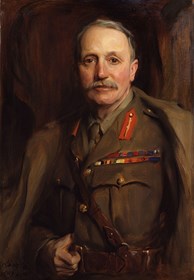
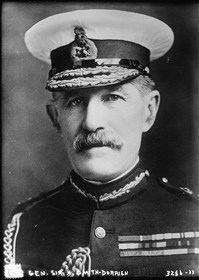

Above: Left to Right Lt-Gen Sir William Pulteney; Lt-General Sir Horace Smith-Dorrien; Brigadier General Sir Charles Briggs (Image of Briggs courtesy and © Victoria and Albert Museum, London).
Protecting this gap was 1st Cavalry Brigade, commanded by Brigadier General Sir Charles Briggs. This brigade was made up of 3 regiments of cavalry: the 2nd Dragoon Guards (Queen's Bays), the 5th (Princess Charlotte of Wales's) Dragoon Guards and the 11th (Prince Albert's Own) Hussars. Each of these regiments had a strength of about 500 men. In support was 'L' Battery, Royal Horse Artillery, with six 13-pounder guns and (when at full strength) nearly 200 officers and men.
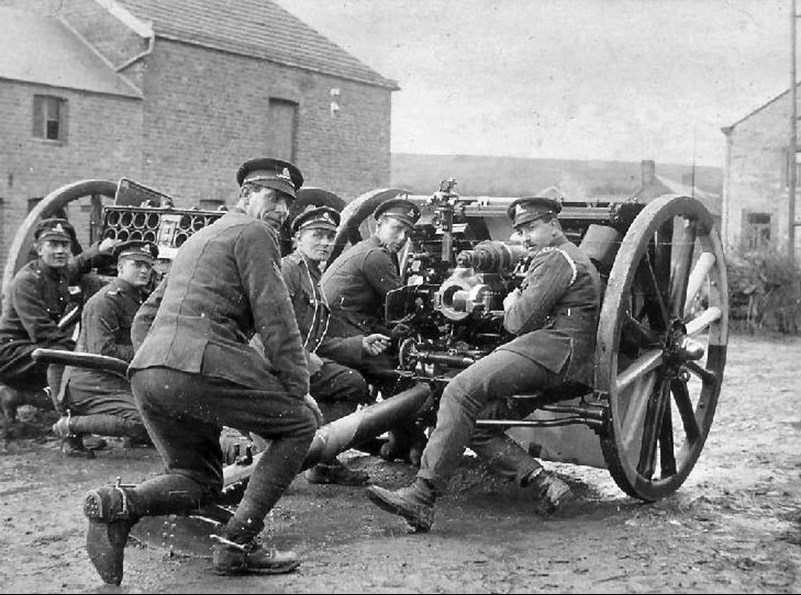
Above: A Royal Horse Artillery 13 pounder Quick Firing gun.
The brigade arrived at Néry on 31 August and found billets in the village, but 'L' Battery, being the last to arrive, had been allocated a field on the south of the village adjacent to a sugar beet factory.
Dawn broke on 1 September with a thick fog laying in the valley to the east of the village which masked a large German force that had come into the area overnight. The German commander made plans for a surprise attack. The British, who had been prepared to move off at 4.30am, but delayed doing so because of the fog, were caught unprepared. The Germans opened up with machine gun and artillery fire - this caused a number of cavalry horses to bolt. The fire also fell among the guns and horses of 'L' Battery. Once of the first casualties was the commander of the battery, Major Walter Sclater-Booth, who was knocked unconscious. As a result the second in command, Captain Edward Bradbury took charge.
Captain Edward Bradbury and the subalterns were standing near the hay stacks in the north-west corner of the field when a shell burst over the battery and immediately the whole field was swept by a devastating fire. The poles being down [this is a reference to the limber poles that sat across the necks of the horses: these had been taken off the horses to avoid them becoming tired], the teams had no chance, and as the horses tried to bolt the poles were driven into the ground and the field rapidly became a shambles. It was a moment that called for a leader, and Bradbury rose magnificently to the occasion.
Shouting for volunteers, he raced for the guns followed by the three subalterns and by Sgt D. Nelson. The officers, assisted by some men who were helping with the horses managed to unlimber three of the guns and turn them in the direction of the enemy. Capt Bradbury took one, Lieut Giffard another, and Lieutenants Campbell and Mundy the third. But the ammunition wagons were twenty yards away and over this death-swept space the rounds had to be carried up to the guns.
Unfortunately a disaster occurred at once for, before it could fire a round, Lieut Campbell's gun was knocked out by a direct hit. The two officers then ran over to Capt Bradbury's gun and reinforced his detachment. The two guns opened fire at once on the enemy, but Lieut Giffard's gun, after firing a very few rounds, was smothered with shells. Lieut Giffard was severely wounded and nearly all the detachment were either killed or wounded. Thus only Bradbury's gun still remained in action, and round this gun gathered the few survivors from the other two guns, and the detachment was further reinforced by Battery-Sergeant-Major GT Dorrell.
Major AF Becke, Royal Artillery Journal.
More detail is provided by Sgt Nelson of 'L' Battery:
During the awful carnage the groaning of dying men and horses was audible amidst the terrific thundering of the cannon. The scenes were in most cases beyond description. One man in full view of me had his head cut clean off his body. Another was literally blown to pieces, another was practically severed at the breast, loins, knees and ankles. One horse had its head and neck completely severed from its shoulders. So terrific was the hail of shrapnel that I was bespattered with blood from men and horses.
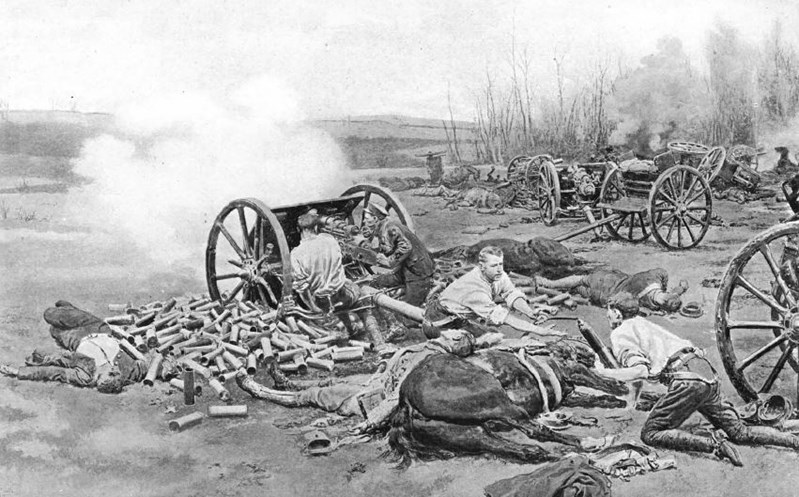
L Battery R.H.A. "How our Gunners Won the V.C. and Silenced the Fire of the German Guns in the Face of Overwhelming Odds." Print by Fortunino Matania. From Deeds that Thrill the Empire (published 1919).
Bombadier Frank Perrett takes up the story:
When the first salvo fell, Gunner Marsh, my Number 2 and I, were just finishing shaving in rear of our detachment horses, which were tied to the gun wheel. A shell dropped right amongst them and the explosion flattened us. I told [Marsh] to lie still as I could see he was badly hit: a piece of shell had gone right through his back and disembowelled him. All hell seemed to be let loose, with shells raining in amongst men and horses, and the screams of the latter could be plainly heard in the din. Then Lieut Campbell came running across and shouted 'get that gun into action!' He and I managed to release the detachment horses from our gun and limber wheels — they were all dead or dying — and we managed to swing the gun round.
Lieut Campbell took the layer's seat and layed by open sights on the German guns, which were now clearly visible, and seemed very close. I opened the limber, threw some rounds by the gun and jumped into Number 2's seat. I set the range at 800 and slammed in a round. Campbell reported 'Ready' and I ordered 'Fire!' We observed the round to be over the target, so I dropped the range to 500 and set the fuze at 'shrapnel zero', loaded, and we fired again. Realising that zero fuze was dangerous to our men and horses in front I set the next round at fuze 1½. We began to get results.
By this time more men came doubling across and took over Numbers 1 and 4, with others getting ammunition. As soon as a full detachment could be made up, Lieut Campbell called me to help him get another gun into action.
Sgt Nelson again:
I resumed inspecting one of my Ammunition Wagons, when presently a terrific and deadly shrapnel fire swept Battery, literally mowing down men and horses. I took cover by the wagons, momentarily dumbfounded, and awaiting orders, but after a second volley of shrapnel, seeing no officers near, called Gunner Darbyshire and with his assistance unlimbered my gun and directed it on the enemy's guns and opened fire.
Just then Captain Bradbury, Lieut Mundy, Corpl Payne and Driver Osborne arrived, and we kept up a destructive fire for some time, Gunner Darbyshire and Driver Osborne heroically carrying ammunition from other wagons to augment the supply already in the Gun limber. Lieuts Campbell and Giffard....brought No 5 Gun ('D') into action, but as they were directly behind my Gun, their shooting at the German Guns was limited.
Lieutenant Giffard had been in away from the battery when the action began. Returning to the battery, he ran to the 'B' sub-section gun with Sergeant Phillips and Gunner Richardson.
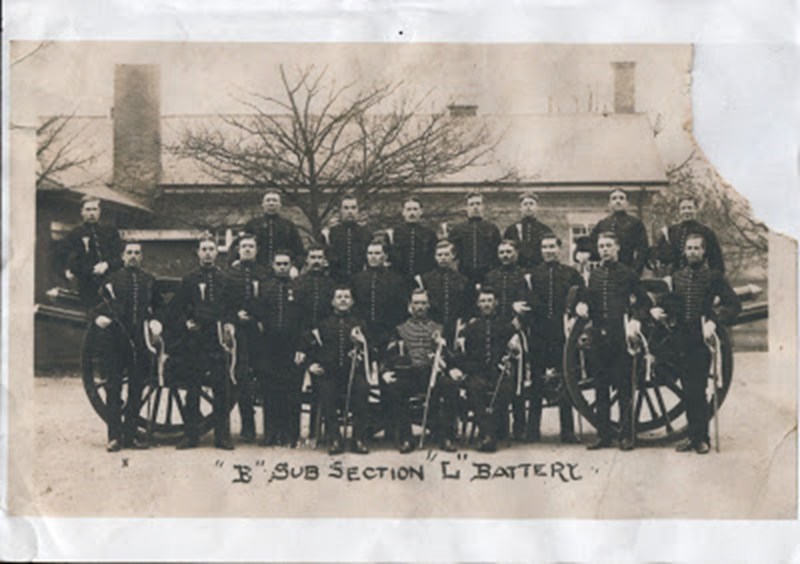
'B' sub-section of 'L' Battery RHA in 1914. Image courtesy of Kenneth Whetlor Blogs
They brought the gun into action and fired only a few rounds when they took a direct hit, this killed Gunner Richardson and wounded most of the detachment. Lieutenant Giffard and Sergeant Phillips carried on until another German shell overturned the gun, killing Sergeant Phillips. Lieutenant Giffard, severely wounded, was able to drag himself to the dubious cover provided by some haystacks, but was wounded again on the way there. Lieutenant Giffard eventually recovered from his wounds and was awarded the Legion of Honour.
Bombadier Perrett:
We doubled to 'C' Sub's gun, loosened the traces from the dead and wounded horses, got the gun round and into action. Lieutenant Campbell jumped into the layer's seat. Gunner Miller did Number Three, another Gunner took Number Four, and I knelt at the trail as Number One, while Driver Mansfield and some others brought up ammunition....
We quickly commenced firing, but it didn't last long. Suddenly there was a blinding flash and for a time I remembered no more.... I soon came to in a dazed condition to find Mr Campbell binding a field dressing round my head. A shell had burst right in front of our shield and a piece had got me in the face. Miller was killed and Mansfield was badly wounded.
Gunner Darbyshire adds his account to the narrative:
Owing to heavy losses in our battery I had become limber gunner, and it was part of my special duty to see to the ammunition in the limbers. But special duties at a time like that don't count for much; the chief thing is to keep the guns going, and now it was a case of everyone striving his best to save the battery... As soon as we got No. 6 gun into action I jumped into the seat and began firing, but so awful was the concussion of our own explosions and the bursting German shells that I could not bear it for long. I kept it up for about twenty minutes, then my nose and ears were bleeding because of the concussion, and I could not fire anymore, so I left the seat and got a change by fetching ammunition. Immediately I left the seat, Lieut Campbell, who had been helping with the ammunition took it and kept the firing up without loss of a second of time. But he had not fired more than a couple of rounds when a shell burst under the shield. The explosion was awful, and the brave young officer was hurled about six yards away from the seat in which I had been sitting a few seconds earlier.
With this gun out of action, Lieut Mundy and Corpl Payne mortally wounded and Lieut Campbell dead, there remained just one gun in action. Nelson again:
There were now three serving the Gun, Capt Bradbury, Sergt Major Dorrell (who up to now had been using a rifle under cover) and myself, twice wounded; we still maintained a quick rate of deadly accurate fire until the ammunition supply began to wane and the two men carrying it to us disappeared.

Above: 'The last Gun at Néry From The Times History of the War, Volume X, 1917
The reason for the disappearance is explained by Darbyshire:
When I felt a little better I began to help Driver Osborne to fetch ammunition from the wagons. I had just managed to get back to the gun with an armful of ammunition, when a lyddite shell exploded behind me, threw me to the ground and partly stunned me. When I came round I got up and found that I was uninjured. On looking round, however, I saw that Captain Bradbury, who had played a splendid part in getting the guns into action, had been knocked down by the same shell that floored me and was mortally wounded. Though the Captain knew that death was very near, he thought of his men to the last and begged to be carried away so that they should not be upset by seeing him...
Eventually, the last Gun of 'L' Battery was silenced, but by having continued firing for two and a half hours, it attracted German fire that would otherwise have been used to help launch an attack on the rest of the Brigade.
During the heroic actions by 'L' Battery, some men of the cavalry regiments had moved into position, on foot, along the eastern edge of the village to prevent an attack by the dismounted German cavalry. At 6am, two squadrons of the 5th Dragoon Guards were sent north to try to outflank the attackers, looping around to the east and to hold them in place. During this action, the commanding officer of the 5th Dragoon Guards, Lt-Col George Ansell was mortally wounded. This action by the 5th Dragoon Guards prevented the German attack on Néry developing. Losses among the German cavalry (the 9th Uhlans) were severe.
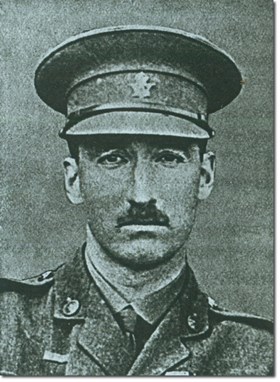
Above: Lt-Col Ansell was the most senior officer to be killed in the action at Néry.

Above: An officer with a Uhlan horse captured in the cavalry action at Néry, 1st September 1914. Image courtesy of the Imperial War Museum. IWM Q 51483
The second highest ranking officer to be killed was Major John Cawley, who was a staff officer of the 1st Cavalry Brigade. John Cawley was born at Crumpsall, Lancashire in 1879, the son of a wealthy cotton merchant Sir Frederick (later Baron) Cawley. John obtained his commission at the Royal Military College, Sandhurst and joined his regiment, the 20th Hussars, at Mhow, India in 1897. In 1913 he became Brigade Major to the 1st Cavalry Brigade. A brother officer gave the following account of John Cawley's death:
Our Brigade was attacked soon after dawn at Néry by a force double our number - a Cavalry Division with 12 guns. Owing to thick mist they managed to get within 600 yards of us; 350 horses of the Bays stampeded and their men went after them, and the 'L' Battery was cut to pieces. The occasion was one which called for personal example, and Major Cawley, by permission of the General, went to help to restore order and get the broken remnants in their places. The situation being met and everyone being in his place, he joined the advance line and was almost immediately killed by a piece of shell. The splendid manner in which he met his death in deliberately facing the awful fire to help others when he really need not have done so, is only what his whole life has led us to expect.

Major John Stephen Cawley (1879-1914) in the uniform of the 20th Hussars. Image courtesy of the National Trust
Eventually reinforcements arrived in the shape of 'I' Battery RHA and the 1st Battalion Middlesex Regiment. There followed a counter attack which scattered the attacking German troops. A number of German artillery pieces were captured. Although often overlooked, the arrival of 'I' Battery decisively swung the outcome - had they not arrived matters may have ended very different.
Although Néry was not a full scale battle and insignificant in terms of the kind of warfare that was to take place over the coming years, it was highly significant. It was the first time the British had forced the Germans to retreat and it created a further breathing space for the hard-pressed BEF from the relentless pursuit by the Germans - and all of this despite being outnumbered and outgunned.
'L' Battery suffered about 25 fatalities on 1 September 1914, with about another thirty or so wounded - this out of a strength of 170. 'L' Battery went on to serve in Gallipoli (where Bombadier Herbert Darbyshire, mentioned above, was killed). According to the CWGC website, the battery's total deaths in the war was 74, meaning about 33% of the total deaths for the entire war for this unit were suffered on just one day. It is unlikely any other unit in the army suffered such a proportion of its deaths in one action.
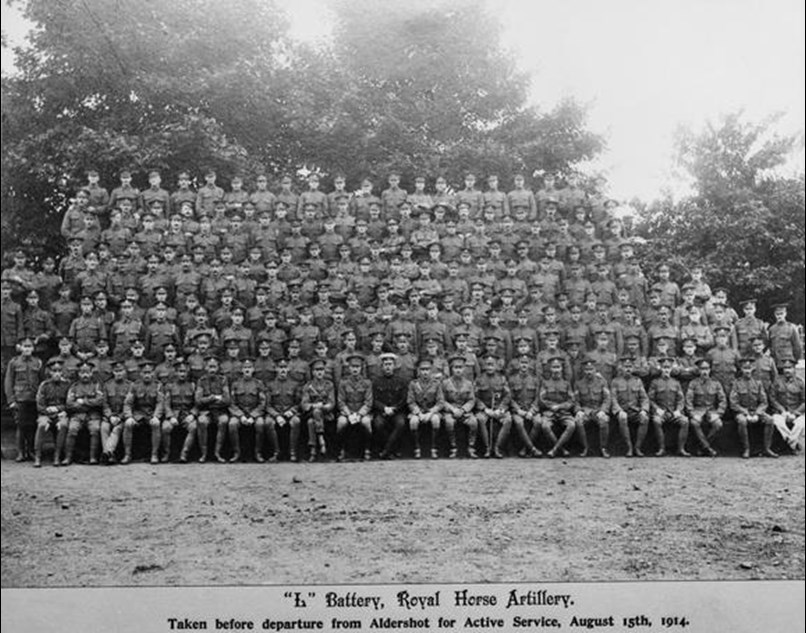
Group photograph of the members of the Battery, taken at Aldershot on 15 August 1914, the day before they left for active service in France. Image courtesy of the Imperial War Museum. HU65205
Three Victoria Crosses were awarded for gallantry amongst the officers and men of 'L' Battery.
Captain Edward Kinder Bradbury. The citation for his VC was published in the London Gazette dated: 25th November 1914.
“For gallantry and ability in organising the defence of ‘L’ Battery against heavy odds at Néry on 1st September.”
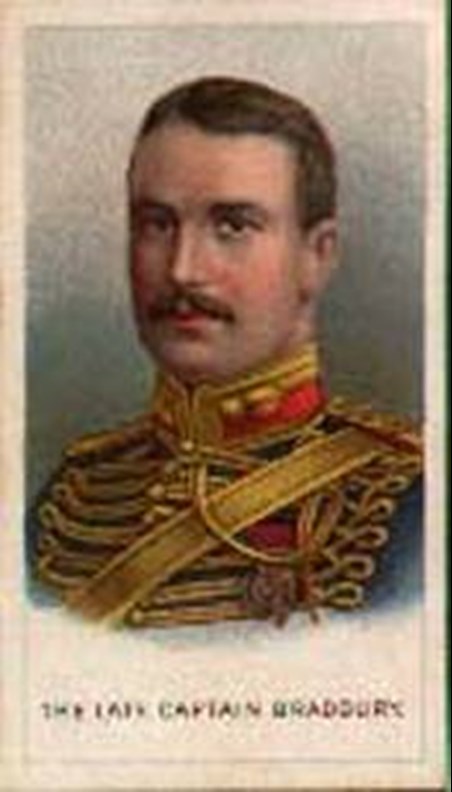
Captain Bradbury is buried at Néry Communal Cemetery.
Sergeant David Nelson survived his injuries and was commissioned. He rose to the rank of Major but was killed in 1918. He is buried at Lillers Communal Cemetery. His citation (published in the London Gazette on 16th November 1914) reads:
“Helping to bring the guns into action under heavy fire at Néry on the 1st September, and while severely wounded remaining with them until all the ammunition was expended – although he had been ordered to retire to cover.”

Battery-Sergeant-Major George Thomas Dorrell (who had served in the Boer War) survived the First World War, served in the Home Guard in World War Two and lived until 1971.
His VC citation was published in the London Gazette on 16th November 1914.
“For continuing to serve a gun until all the ammunition was expended, after all officers were killed or wounded, in spite of a concentrated fire from guns and machine guns, at a range of 600 yards, at Néry on 1st September.”
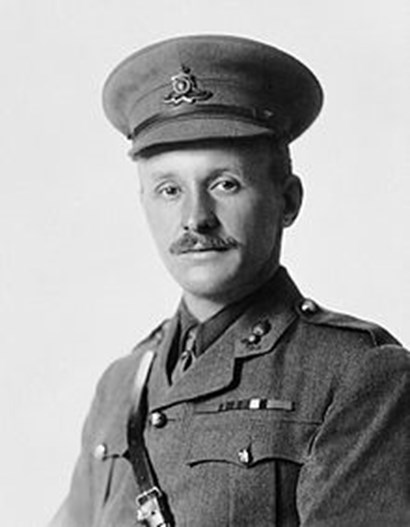
The men from 1st Cavalry Brigade who were killed in this action are buried (or commemorated) mainly in three cemeteries.
Néry Communal Cemetery
Has a large obelisk over a vault which contains the remains of Captain Edward Bradbury, Major John Cawley and Lieutenant John Campbell - all of whom were killed in the action on 1 September.
Also buried in this vault, somewhat surprisingly, is Captain Oswald Cawley who died in 1918 near the Belgian border. Oswald was the bother of Major John Cawley and just prior to his death had been elected as a Member of Parliament for Prestwich succeeding his father as MP.

Oswald was buried near where he fell, but his father (1st Baron Cawley) was a man of influence - he had served in the Government as Chancellor of the Duchy of Lancaster - requested in January 1919 that Oswald be buried with his brother at Néry. The following month, the Imperial (as it was) War Graves Commission informed Lord Cawley that "at present it is not possible for request to be complied with". An exchange of letters then ensued between various people within the IWGC and Lord Cawley - during which it is ascertained that this was a question of expense and logistics rather than IWGC policy. Lord Cawley then attempted to buy land where Oswald was buried, but was prevented by French Government policy, so Oswald's grave was moved to Chocques Military cemetery in August 1919. In December 1919 Lord Cawley again attempted to persuade the IWGC to bury his sons together, this could not be done at the time due to the IWGC interpretation of French Policy, however the IWGC said it would be “carefully noted for future consideration” by IWGC. This reconsideration took place in March 1920, and in August 1920 Oswald was reburied in Néry.
In the centre of Néry Communal Cemetery are four headstones plus a common plot with a stone commemorating twelve men of 'L' Battery.

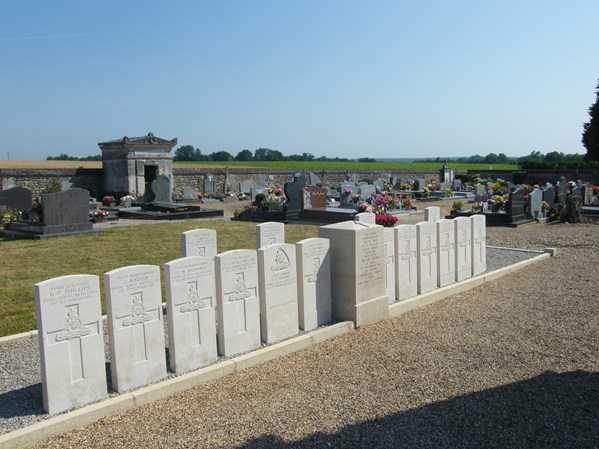
These twelve men are possibly unique in that they have two listings each on the CWGC website. The reason is that it is not known where they are buried. It is known seven were buried at Néry Communal Cemetery and five at Verberie, but the burials were undertaken by the Germans and who is buried in which cemetery is not known.
Verberie French National Cemetery
This cemetery contains the same 'duplicate' commemorations as seen at Néry Communal Cemetery, but also buried here are a number of the officers and men from the 2nd Dragoon Guards and the 5th Dragoon Guards who were killed in the action on 1st September. This includes the grave of Lt-Col George Ansell.
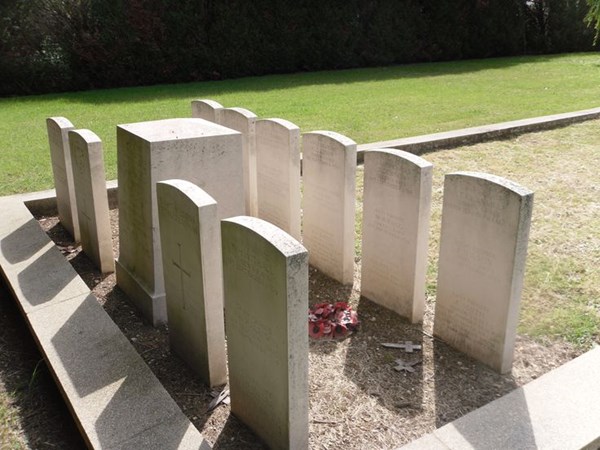
This cemetery is to the south of Néry. Among those buried here is Lieutenant Lionel Mundy who served the gun at Néry with distinction. He died of wounds on 3rd September.

Also at Baron Communal Cemetery are eight men of the 2nd Dragoon Guards (Queen's Bays).
Not buried among them, however, is Lieutenant Claude Champion de Crespigny. Claude was originally buried at Néry but was then disinterred and his body returned home to be buried in the family mausoleum at Champion Lodge, Maldon, Essex, which his father had built in the grounds for his eldest son.
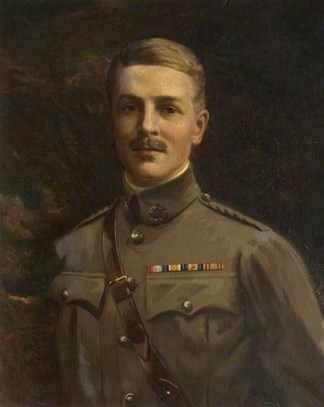
The exhumation had been difficult, buried as he was in a grave with 17 other soldiers. He was eventually identified by the name on the neckband of his shirt. The ceremony, carried out with full military honours, was recorded in the Essex County Chronicle on 13 November 1914.
"The body, enclosed in a coffin of polished oak, with silver-plated furniture, arrived in London on Monday, and was conveyed to Maldon by train on Tuesday. Major General Heath, of the South Midland Division, sent a gun carriage, on which the remains were conveyed to Champion Lodge. Sir Claude and Lady de Crespigny met the train and followed the coffin to their residence, Sir Claude walking behind the gun carriage."
The Néry Gun is on display at the Imperial War Museum in London.
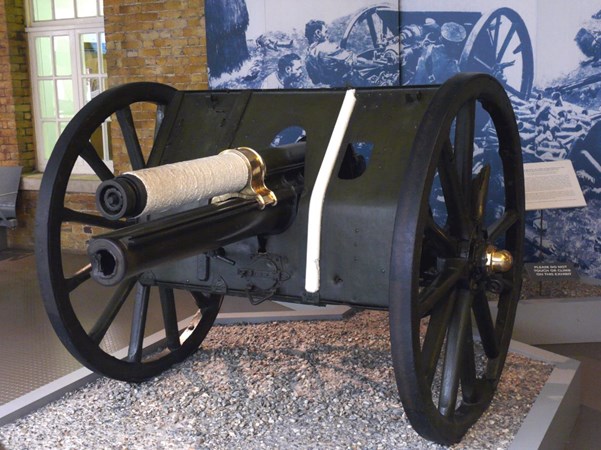
The Néry Gun. Damage to the muzzle, caused by the German artillery fire can be seen. Image by Andrew Gray via Flickr
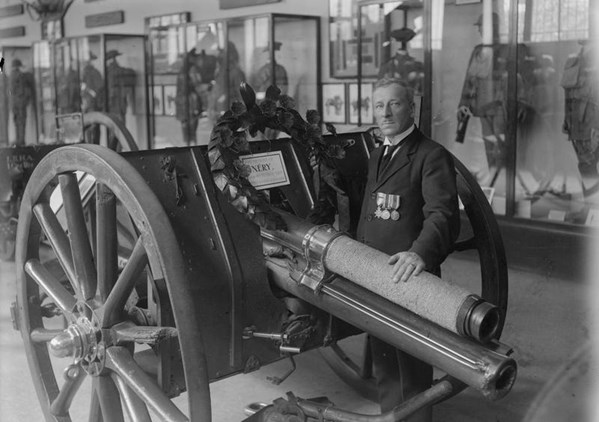
Driver Drane, an original member of L Battery, Royal Horse Artillery, placing a wreath on the gun on the anniversary of the action of L Battery at Néry (in 1926). The wreath was sent by serving officers and men of the Battery stationed at Risalpur, India. Image courtesy of the Imperial War Museum Q 44245
Article by David Tattersfield, Vice Chairman, The Western Front Association





